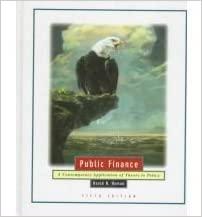Question
Survivor, Inc. is considering investing in two independent projects: a modified fishing vessel and a bear trap. The cash outlay for the fishing vessel is
Survivor, Inc. is considering investing in two independent projects: a modified fishing vessel and a bear trap. The cash outlay for the fishing vessel is $45,000, and for the bear trap it is $35,000. Each piece of equipment has an estimated life of 5 years. The expected annual after-tax cash flow to be provided by the fishing vessel is $12,500 each of the 5 years, and for the bear trap it is $8,500 each year. The firms required rate of return is 8%.
Calculate the Payback Period for the Fishing Vessel, the Payback Period for the Bear Trap, and the Discounted Payback Period for the Fishing Vessel.
What is the Discounted Payback Period for the Bear Trap? Select one:
a. 4.8 years
b. 5.1 years
c. 5.2 years
d. Beyond 5 years - No Payback
Calculate the Net Present Value for the Fishing Vessel, the Net Present Value for the Bear Trap, the Internal Rate of Return (IRR) for the Fishing Vessel, and the Internal Rate of Return (IRR) for the Bear Trap.
Based upon the NPV results, which project(s) should be accepted for investment?
Select one:
a. Fishing Vessel
b. Bear Trap
c. Both the Fishing Vessel and the Bear Trap
d. Neither the Fishing Vessel nor the Bear Trap.
When evaluating a project using the Internal Rate of Return (IRR) method, what is the standard decision-making rule?
Select one:
a. Accept any project with a positive IRR.
b. Accept any project with an IRR greater than its cost of capital.
c. Accept any project with an IRR less than the expected life of the project.
d. Accept any project with an IRR greater than 10%
Step by Step Solution
There are 3 Steps involved in it
Step: 1

Get Instant Access to Expert-Tailored Solutions
See step-by-step solutions with expert insights and AI powered tools for academic success
Step: 2

Step: 3

Ace Your Homework with AI
Get the answers you need in no time with our AI-driven, step-by-step assistance
Get Started


